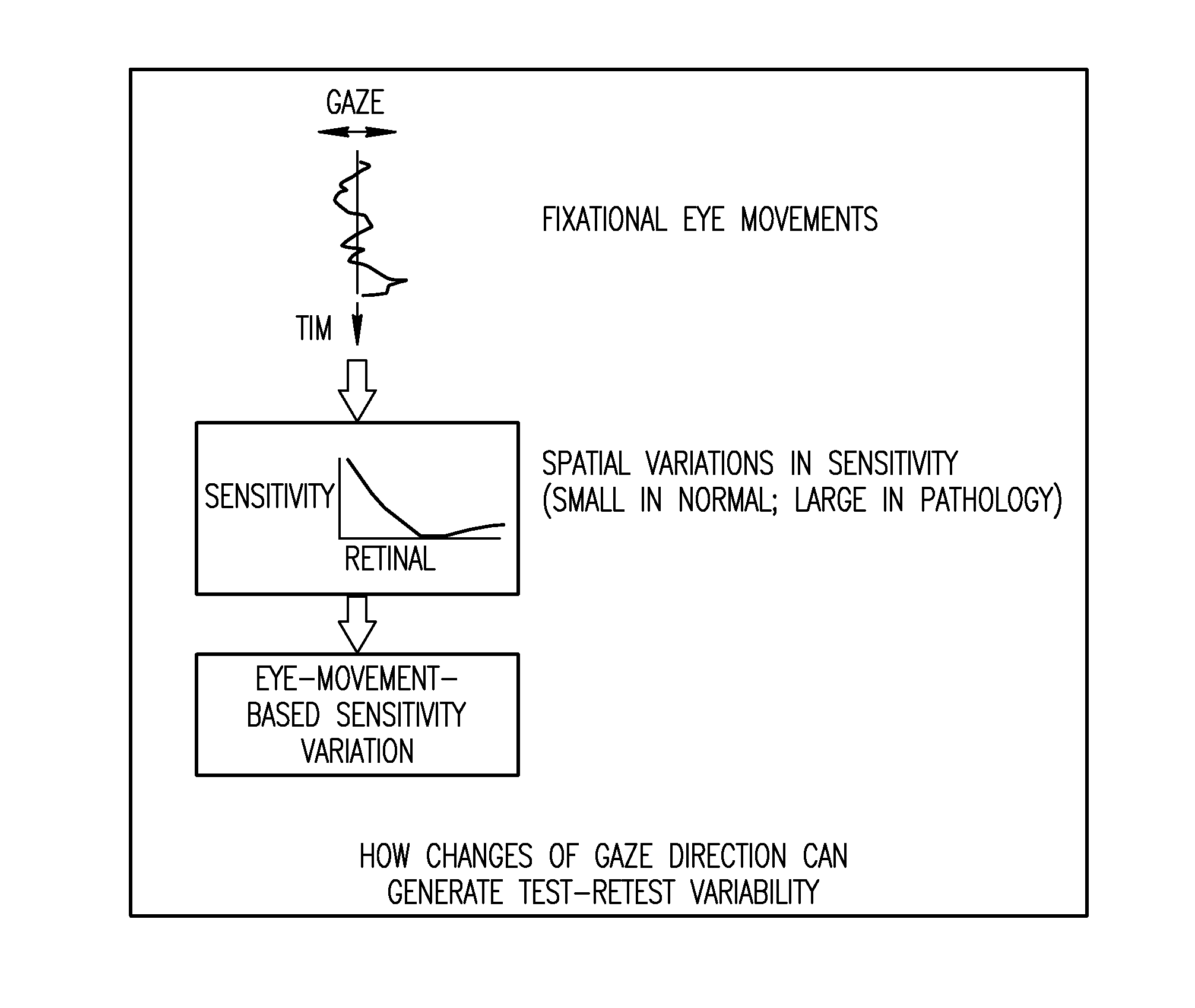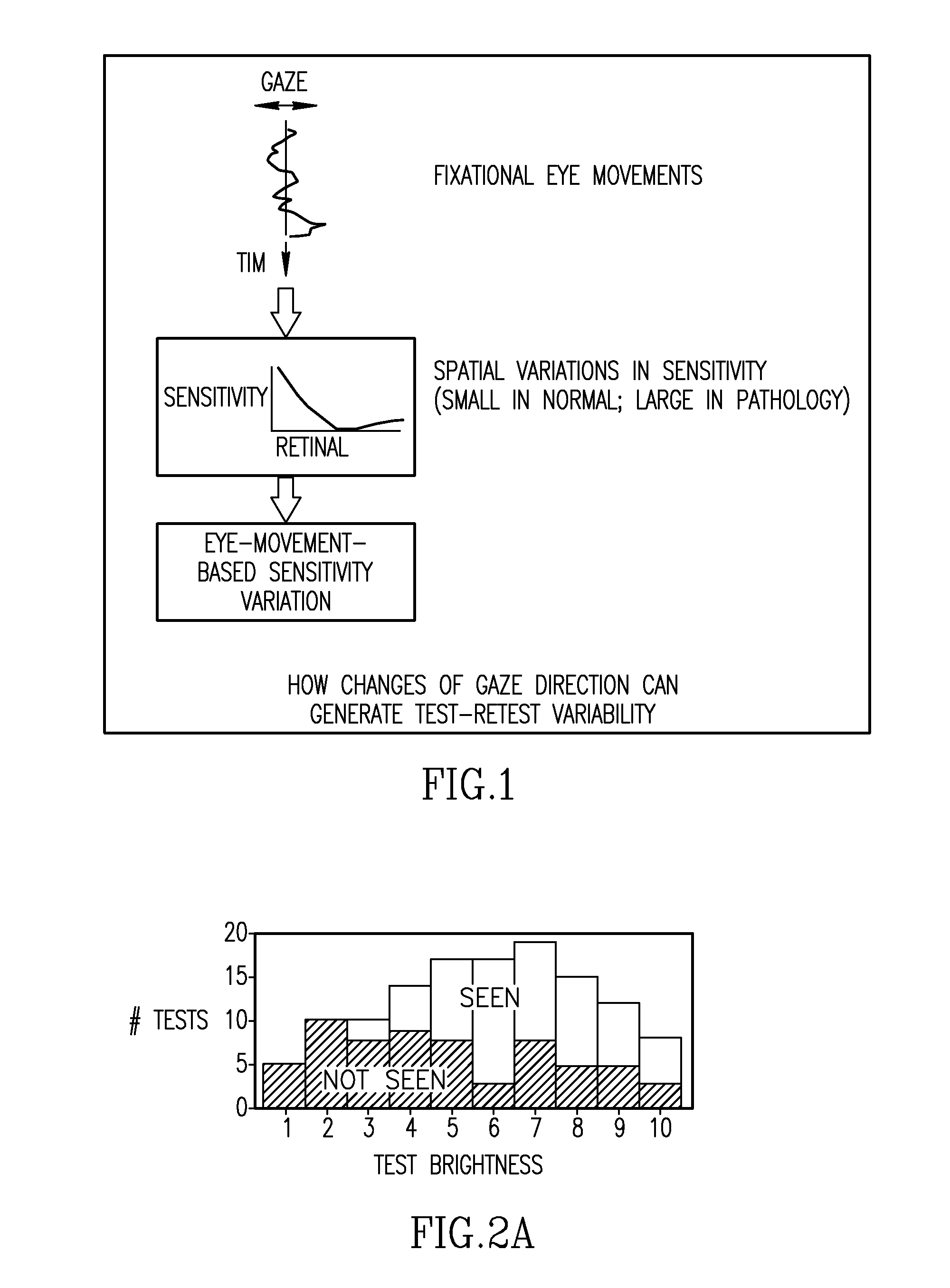Methods for reducing test-retest variability in tests of visual fields
a technology of visual field and variability, applied in the field of test-retest variability in visual field tests, can solve the problems of difficult to determine whether a patient's condition is stable or progressing, defects in visual field, and rapid change of sensitivity
- Summary
- Abstract
- Description
- Claims
- Application Information
AI Technical Summary
Benefits of technology
Problems solved by technology
Method used
Image
Examples
example 1
[0038]If a substantial part of test-retest variability results from fixational eye movements, this could be corrected post hoc with eye movement information. 7 normal subjects were tested with a rectangular test array (4×7; 2 deg spacing), extending from 11 deg to 17 deg in the temporal field, encroaching on the blind spot. Additional control locations were placed in nasal, superior, and inferior visual field. Visual stimuli (size III, 0.1 sec) were presented on a CRT (Radius) with a background luminance of 5 cd / m2. Testing employed a 2 dB / 1 dB two-reversal staircase. Gaze direction was recorded continuously with a video-based eyetracker (ISCAN). Subjects participated in at least two testing sessions.
[0039]Subjects showed variability of gaze-direction which could be described by a normal distribution with SD between 0.2 and 0.5 deg. For each subject, one or more test locations showing substantial test-retest variability was selected for further analysis. 15 test locations in 7 eyes ...
example 2
Using Gaze-Direction Data to Improve the Estimate of Scotoma Edges
[0041]The apparatus employed herein has been previously described in Wyatt H J, Dul M W, Swanson W H. Variability of visual field measurements is correlated with the gradient of sensitivity. Vision Res 2007; 47:925-936. Briefly, visual stimuli were presented on a display monitor (Radius PressView 21 SR, Miro Displays, Inc., Germany) driven by a Power Macintosh G3 computer. The display monitor was a 2100 CRT monitor with 38.0×27.8 cm active area, resolution 832×624 pixels, and frame rate 75 Hz. The monitor was calibrated with a luminance meter (LS-100, Minolta, Japan). The monitor was 75 cm from the recorded eye, so it 29.1 deg horizontally and 21.8 deg vertically at the eye.
[0042]Eye movements (gaze direction) and pupil diameter were measured using a PC-based infrared eyetracker (ISCAN EC-101, ISCAN, Inc., Burlington, Mass.) at a sample rate of 60 / sec. Experiments were controlled by the Macintosh computer; digital I / O...
PUM
| Property | Measurement | Unit |
|---|---|---|
| luminance | aaaaa | aaaaa |
| luminance | aaaaa | aaaaa |
| luminance | aaaaa | aaaaa |
Abstract
Description
Claims
Application Information
 Login to View More
Login to View More - R&D
- Intellectual Property
- Life Sciences
- Materials
- Tech Scout
- Unparalleled Data Quality
- Higher Quality Content
- 60% Fewer Hallucinations
Browse by: Latest US Patents, China's latest patents, Technical Efficacy Thesaurus, Application Domain, Technology Topic, Popular Technical Reports.
© 2025 PatSnap. All rights reserved.Legal|Privacy policy|Modern Slavery Act Transparency Statement|Sitemap|About US| Contact US: help@patsnap.com



